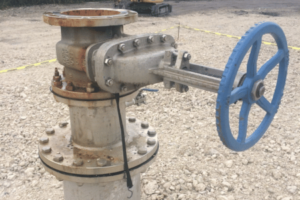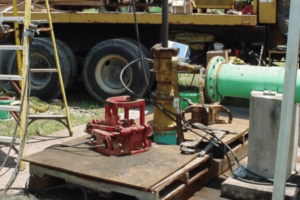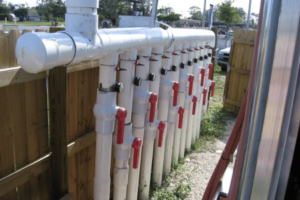Whereas traditional wells harvest water from porous, underground geologic formations, injection wells are versatile systems used across various industries and applications that direct fluid into those formations. They are found in both environmental reclamation and business operations.
The specific design of an underground injection well will vary based on several factors, including the formation it is being used to place fluid into and the substances it will deliver. Underground injection wells can be used to place fluid into shallow layers of soil or deep limestone or sandstone formations, and they can handle fluids such as brine (salt water), wastewater, water, or a solution including hazardous chemicals.
With all of that in mind, let’s further examine the various classes and use cases of injection wells.
Table of Contents
What Does an Injection Well Do? A Closer Look at Its Function and Applications
What is an injection well? Fully answering such a question requires discussing the basic principles behind their construction and industry-specific applications of these important systems.
The Basic Principles of Injection Wells

Constructing a well that handles carbon dioxide and delivers it into deep, isolated geologic formations, for instance, will require a time- and labor-intensive construction process, as it must be insulated with multiple layers of cement and protective materials to guard against seepage, leaks, or spills.
In contrast, designing a shallow injection well that will only handle uncontaminated water involves a far simpler construction process and can be constructed for a relatively minimal cost. Regardless of the complexity of an injection well, the basic premise of these systems remains the same: They are designed to inject water underground.
Applications of Injection Wells Across Industries
Though there is a multitude of applications for injection wells, some of the most common use cases include the following:
- Oil and gas production
- Waste site remediation
- Aquifer recharging
- Geothermal energy generation
- Waste disposal
Naturally, protecting underground sources of drinking water (USDW) is also a primary concern when placing, constructing, and using injection wells. Nevertheless, the injection well’s intended use case will significantly impact its design and location.
Injection Well Classes: Understanding the Different Types
Now that we have explored the question “What is an injection well?” and examined its function, let’s shift our focus to the six classes of injection wells.
As part of the Environmental Protection Agency (EPA)’s Underground Injection Control Program (UICP), these classes are determined based on the well’s depth and type of injection activity and the likelihood that said activity could endanger USDW.
The six classes of injection wells are as follows:
Class 1: Industrial and Municipal Waste Disposal
A Class 1 injection well is used to dispose of municipal and industrial waste, which may or may not be hazardous, that is generated from a wide range of industries and processes, such as:
- Commercial activities
- Petroleum refinement
- Production of pharmaceuticals, metals, chemicals, and foods
The well will dispose of the waste by moving it into deep rock formations, which are usually located thousands of feet underground. Like all other classes, Class 1 injection wells are regulated by the EPA and the UICP.
Class 2: Oil and Gas-Related Injection
Class 2 represents the largest category of injection wells, with thousands of applicable models in operation across the United States. Class 2 injection wells are often used for various applications within the oil and gas sector, and the category itself is divided into the following three categories:
Disposal Wells
The oil and gas industry uses disposal wells to unload various forms of wastewater, including those produced during oil and gas extraction. Disposal wells are also used to manage flow back water, which is the water that returns to the surface following hydraulic fracturing.
Enhanced Recovery Wells
Enhanced recovery wells inject fluids (and occasionally natural gasses) into oil-bearing formations, which forces the oil toward the surface to assist with recovery.
Hydrocarbon Storage Wells
Most hydrocarbon storage wells support the nation’s Strategic Petroleum Reserve. These wells pump liquid hydrocarbons, such as oils, underground.
Class 2 injection wells are used almost exclusively in states that produce gas and oil, and most hydraulic fracturing wells (i.e., recovery wells) are exempt from the UICP. The sole exception is for fracturing wells that inject diesel fuels underground.
Class 3: Solution Mining
A Class 3 injection well is used for solution mining, pumping fluids into underground mineral reserves to dissolve them and then pump them to the surface. These wells are often used for uranium, salt, and (in some cases) copper mining.
Solution mining well systems are particularly sophisticated, given that they deal with chemicals that could cause significant harm should they be inadvertently pumped into USDW reserves. The exact solution used will vary depending on which minerals miners are attempting to harvest.
Class 4: Hazardous and Radioactive Waste Disposal
Class 4 injection wells were shallow wells designed to dispose of radioactive or otherwise hazardous wastes above or in a geologic structure containing USDW. Unsurprisingly, the EPA has banned the widespread use of these types of injection wells since 1984 due to their propensity to taint underground drinking water sources.
However, the EPA will occasionally authorize their use when they are being operated as part of a closely regulated groundwater remediation project. According to the EPA, fewer than 32 such wells are in operation in the U.S., and they typically use a shallow septic system to facilitate proper waste disposal.
Class 5: Other Injection Well Types
Class 5 injection wells are similar to class 4 wells in that they dispose of waste above or into the geologic structures that contain underground sources of drinking water. The difference lies in the fact that Class 5 injection wells only inject non-hazardous fluids near USDW sources. Still, despite being classified as “non-hazardous,” such materials can still threaten the potability of underground drinking water sources if operations are not tightly regulated.
Most Class 5 injection wells rely on gravity to get fluids underground, though there are more than 20 subtypes of Class 5 injection wells. Most of these are rudimentary systems, such as:
- Agricultural drainage wells
- Septic system leach fields
- Stormwater drainage wells
However, deep, complex wells within the Class 5 injection well category are often found at industrial and commercial facilities. Some of the most common types of deep Class 5 wells include:
- Salinity control wells
- Geothermal power generation wells
- Aquifer recovery wells
Regardless of the depth and complexity of a Class 5 injection well, its operators and owners must protect all sources of USDW from contamination.
Class 6: Geologic Sequestration of Carbon Dioxide
Class 6: Geologic Sequestration of Carbon Dioxide
Class 6 injection wells are specifically used for geologic sequestration (GS), the process through which carbon dioxide is injected into geologic formations that are hundreds of feet underground. A Class 6 injection well aims to reduce the amount of CO2 in the atmosphere and combat the effects of global warming.
The Class 6 injection category is the newest under the UICP, having been devised in 2011, and wells that fall under the Class 6 categorization are usually managed at the state level. Therefore, owners and operators must consult with state regulators to ensure compliance with relevant laws.
When creating laws regarding the use of Class 6 injection wells, state regulatory authorities must address factors such as:
- Siting
- Construction
- Operation
- Testing
- Monitoring
- Decommissioning
Each of these regulations shares a key purpose: protecting USDW. As such, organizations that fail to adhere to these requirements will threaten drinking water sources and face stiff penalties. A single violation can result in a catastrophic incident, exposing an organization to thousands in fines and leading to permit revocation.
The Role of Regulation and Compliance in Injection Well Operations
Due to their propensity to negatively impact USDW and the communities that rely on them, injection wells are heavily regulated at both the state and federal levels.
Ensuring Safe and Responsible Injection Well Operations
Owners and operators of injection wells must familiarize themselves with the established regulations for the safe operation of their wells.
The EPA and state regulatory entities have established comprehensive guidelines governing the siting, construction, use, testing, monitoring, and decommissioning of all classes of injection wells. Adhering to these guidelines will enable operators to preserve USDW and protect the communities adjacent to well sites.
Additionally, ensuring the safe and responsible operation of injection wells will enable system owners to preserve their organization’s reputation and avoid stringent regulatory penalties. Under current laws, violators will not only face severe fines but they can also be held accountable for cleanup and remediation.
Key Regulatory Agencies and Their Roles
The EPA is the primary regulatory authority governing injection wells’ siting, construction, and operation. Specifically, injection wells fall under the purview of the EPA’s UICP. That said, the EPA has largely delegated the responsibility of managing and enforcing injection control guidelines to state entities.
However, the EPA directly governs injection control programs in most tribal areas and a handful of states, such as:
- Alaska
- Colorado
- The District of Columbia
- Indiana
- Iowa
- Kentucky
- Michigan
- Minnesota
- Montana
- New York
- Pennsylvania
- Virginia
Alaska, Colorado, Indiana, and Montana manage Class 2 injection well operations within their respective jurisdictions, while the EPA oversees the operation of all other classes of injection wells in those states.
Furthermore, the EPA (or its state designee) must address criteria and requirements such as:
- Site criteria
- Operational requirements
- Construction and material guidelines
- Financial responsibilities of owners/operators
- Reporting and recordkeeping responsibilities
If you need to obtain specific information regarding injection well regulations within your state, consult with regulatory authorities within that jurisdiction. If you are located in one of the 12 jurisdictions the EPA manages directly, regulatory information can be found on the Underground Injection Control Program’s web pages.
When to Contact AOTC
As you can see, there is a lot to unpack when examining the question, “What is an injection well?” Since these systems are used in a variety of industries and are closely regulated at both the state and federal levels, it is critical that you do your due diligence prior to participating in an injection well project.
If you would like assistance with injection well project planning or simply need more information about these systems, Alpha-Omega Training and Compliance can help. We have extensive experience with injection wells and can answer any questions your organization may have.


